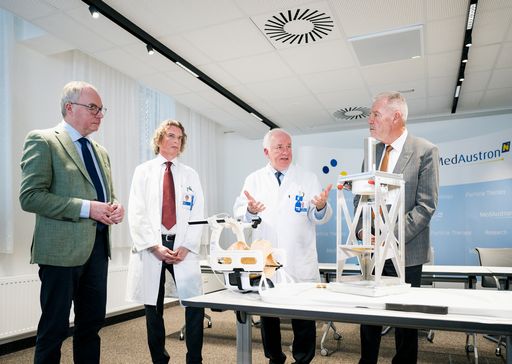Since 2016, the MedAustron ion therapy and research center in Wiener Neustadt has been one of the world’s leading facilities that treat cancer patients using protons and carbon ions. With over 2,700 treatments completed and the significant milestone of the first proton treatment of a patient with uveal melanoma in Austria, the center is setting new standards in cancer therapy. This new expansion, recent study results and future development plans were presented today in a press conference with Deputy Governor Stephan Pernkopf and Chairman of the Supervisory Board Klaus Schneeberger.
With introductory words, Stephan Pernkopf emphasized the importance of science and research and underlined that the political framework must be in place so that patients can regain courage and hope:
“We all know someone in our private lives who is faced with a cancer diagnosis and know the enormous burden that this brings. In such moments, quick help and effective treatment are the most important support. Giving this hope and confidence to those affected was always a goal of MedAustron. In Wiener Neustadt we offer high-precision treatment that is only possible at six locations worldwide. It is particularly important to us that people do not have to travel long distances after such a diagnosis. The best possible cancer treatment is available right here in Lower Austria.” – Stephan Pernkopf
With innovative cancer treatment and research, MedAustron makes a significant contribution to healthcare in Lower Austria and beyond the state’s borders. Clinical studies are an essential component at MedAustron in order to generate objective evidence according to international standards for the effects of ion therapy or individual therapy concepts. A prospective registry study for all patient groups as well as several disease-specific clinical studies continuously provide data that are continually published in specialist journals. In this context, MedAustron’s study department will now also be funded by the state of Lower Austria with up to 1.8 million euros for the years 2025 to 2029.
“The state of Lower Austria would like to raise fresh money for the study department, so an additional 1.8 million euros are being invested. This means that the research results can be brought to patients even more quickly – research that saves lives” – Stephan Pernkopf
This funding will ensure the realization of clinical studies that, in collaboration with other radiation oncology centers in Austria, will define the value of particle therapy for selective indications compared to conventional radiation therapy.
Around 250 employees from more than 20 nations at MedAustron pursue the common goal of curing cancer and maintaining or improving the quality of life of patients. The interdisciplinary collaboration between medicine and technology is the heart of MedAustron.
Klaus Schneeberger, Chairman of the MedAustron Supervisory Board, emphasizes: “We have great employees, the best experts in the technical, physical and medical fields, which means that we have a competence center here that is unparalleled in Europe.”
He reflected on the creation of MedAustron and emphasized that the center is one of the few examples of how the basic research of the European particle physics laboratory CERN can be successfully applied, and how an agreement between the federal government, the state of Lower Austria and the city of Wiener Neustadt in 2004 paved the way paved for construction.
After six years of interdisciplinary development and preparation, MedAustron now also offers a new treatment method: the first patient with uveal melanoma was treated with protons in November 2024. The successful integration into existing systems and workflows enables MedAustron to now carry out the treatment of uveal melanomas and, thanks to the advantages of ion therapy, to optimally protect sensitive structures in the immediate vicinity.
Medical director and managing director Eugen B. Hug explained: “The challenge was to implement the eye treatment with the precision of this system and at the same time to develop a system that is flexible and can be dismantled and assembled as required. This flexibility means the system can be easily integrated into everyday hospital life, for example if only two eye treatments out of a total of 50 treatments are planned on the premises.”
He continued: “MedAustron is guided by three mandates: the center is well established in radiation oncology in Austria; We ensure the creation of evidence through clinical studies, and the symbiosis of medicine – medical physics – physics allows us to pioneer completely new treatment options, such as the treatment of uveal melanoma.”
MedAustron’s impact already extends from the regional to the international level. Nationally, the center is well integrated into the domestic oncological therapy landscape and represents a contact point in Europe, especially for Central and Eastern European countries, as there are no proton centers in these regions. Internationally, MedAustron is an important partner for other particle therapy centers, both in terms of collaboration in clinical studies and as a topic leader for the future development of the therapy. This path will continue in the future to offer those affected courage, hope and support in the fight against cancer.
